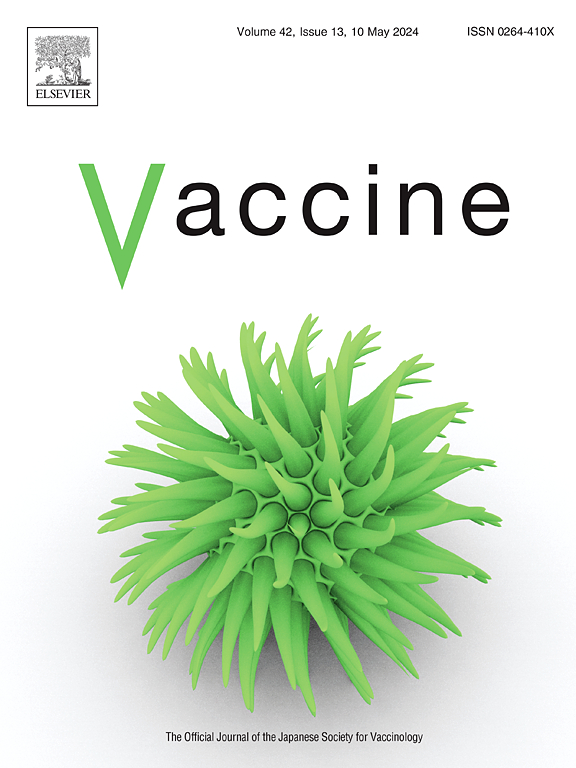自组装蛋白纳米颗粒(SAPN)技术递送hla限制性肽疫苗候选物的免疫原性
IF 4.5
3区 医学
Q2 IMMUNOLOGY
引用次数: 0
摘要
疟疾感染仍然是世界范围内的一个重大威胁,由于疟原虫的复杂性,开发一种诱导长期无菌免疫的疫苗证明是困难的。在靶抗原内发现保守的和人类白细胞抗原(HLA)混杂的保护相关表位,为开发有效的疫苗提供了希望。我们先前使用来自加纳南部半免疫个体的样本,在选定的恶性疟原虫(Pf)抗原中鉴定了免疫优势T细胞区域。目的是利用自组装蛋白纳米颗粒(SAPN)递送平台,设计、生产和评估含有保守和混杂HLA i类限制性表位的f抗原特异性疫苗的免疫原性。我们根据早期研究中从Pf抗原(PfCSP、PfAMA1和PfTRAP)中鉴定的表位,以及HLA超型HLA A*02和HLA A*03,生产了5种SAPN疫苗。分别以3、7和10 μg剂量免疫转基因HLA A*02和A*03小鼠,分别用IFN-γ/IL2 FluoroSpot和免疫荧光抗体法(IFA)检测细胞应答和对孢子虫的抗体水平。接种CSP A*02 SAPN疫苗的转基因小鼠对插入表位、NANPNANPNV和AILSVSSFLF的IFN-γ t细胞应答增强,对Pf孢子虫的抗体应答显著提高(接种组的中位滴度 = 10,240,佐剂组为10,p值 = 0.0003)。含有A*02表位YMGNPWTEYM的AMA1 SAPN疫苗在10 μg剂量组诱导的中位IFN-γ sfc/m为259,而仅佐剂组的应答为47 sfc/m (p值 = 0.03)。AMA1 A*03表位NSTCRFFVCK在10和3 μg剂量下分别诱导了180和217中位IFN-γ sfc/m,而两种剂量下仅佐剂应答均为0 sfc/m (p值 = 0.0079)。我们的方法证明了开发一种新的潜在有效的基于表位的疫苗的可行性,并肯定了SAPN技术作为有效递送平台的潜力。本文章由计算机程序翻译,如有差异,请以英文原文为准。
Immunogenicity of HLA-restricted peptide vaccine candidates delivered by self-assembling protein nanoparticle (SAPN) technology
Malaria infection remains a significant threat worldwide, with the development of a vaccine that induces long-term sterile immunity proving difficult due to the complexity of the parasite, Plasmodium. The identification of conserved and human leukocyte antigen (HLA)-promiscuous, protection-associated epitopes within target antigens offer promise of developing effective vaccines. We previously identified immunodominant T cell regions within selected P. falciparum (Pf) antigens using samples from semi-immune individuals in Southern Ghana. The aim was to design, produce and assess immunogenicity of Pf-antigen-specific vaccines containing conserved and promiscuous HLA class I-restricted epitopes using the self-assembling protein nanoparticle (SAPN) delivery platform. We produced five SAPN vaccines based on epitopes identified in our earlier studies from Pf antigens (PfCSP, PfAMA1 and PfTRAP) and presented by HLA supertypes HLA A*02 and HLA A*03. The vaccines were used to immunize transgenic HLA A*02 and A*03 mice at 3, 7 and 10 μg doses, and the levels of cellular responses and antibodies to sporozoites assessed by IFN-γ/IL2 FluoroSpot and immunofluorescence antibody assays (IFA), respectively. Transgenic mice vaccinated with the CSP A*02 SAPN vaccine elicited increased IFN-γ T-cell responses against the inserted epitopes, NANPNANPNV and AILSVSSFLF and significantly higher antibody responses against Pf sporozoites assessed by IFA (median titer = 10,240 in vaccinated group vs 10 in adjuvant group, p value = 0.0003).The AMA1 SAPN vaccine containing the A*02 epitope YMGNPWTEYM elicited a median IFN-γ sfc/m of 259 in the 10 μg dose group while the adjuvant only response was 47 sfc/m (p value = 0.03). The AMA1 A*03 epitope NSTCRFFVCK elicited a median IFN-γ sfc/m of 180 and 217 in the 10 and 3 μg doses respectively, while the adjuvant only response was 0 sfc/m for both doses (p value = 0.0079). Our approach demonstrates feasibility of developing a novel potentially efficacious epitope-based vaccine and affirms the potential of the SAPN technology as an effective delivery platform.
求助全文
通过发布文献求助,成功后即可免费获取论文全文。
去求助
来源期刊

Vaccine
医学-免疫学
CiteScore
8.70
自引率
5.50%
发文量
992
审稿时长
131 days
期刊介绍:
Vaccine is unique in publishing the highest quality science across all disciplines relevant to the field of vaccinology - all original article submissions across basic and clinical research, vaccine manufacturing, history, public policy, behavioral science and ethics, social sciences, safety, and many other related areas are welcomed. The submission categories as given in the Guide for Authors indicate where we receive the most papers. Papers outside these major areas are also welcome and authors are encouraged to contact us with specific questions.
 求助内容:
求助内容: 应助结果提醒方式:
应助结果提醒方式:


